New York City Mayor Eric Adams, once seen as a unifying force bridging diverse political factions, has reportedly seen his once-robust coalition unravel, leading to a diminished standing in the city’s political landscape. What began as a broad alliance of working-class voters, outer-borough residents, and business interests has seemingly fractured under the weight of policy challenges, shifting public sentiment, and internal dissent.
Upon taking office, Adams cultivated an image as a pragmatic leader capable of tackling the city’s most pressing issues, from public safety to economic recovery. His initial support base was a testament to his ability to appeal across traditional Democratic divides, securing endorsements from both centrist and more progressive elements, albeit cautiously from the latter. This diverse backing was crucial to his electoral success.
The Erosion of Support
However, over the course of his tenure, various factors contributed to the slow but steady erosion of this coalition. Key policy decisions and the administration’s handling of critical issues began to alienate specific segments of his original base. The ongoing migrant crisis, for instance, put immense strain on city resources and sparked controversy over housing strategies, drawing criticism from both progressive advocates and some long-time residents concerned about neighborhood impacts and financial burdens.
“His initial promise was to be a mayor for all New Yorkers, but somewhere along the line, the narrative shifted,” stated Dr. Lena Chen, a political science professor at CUNY. “Whether it was the budget cuts affecting public services, the perceived coziness with real estate developers, or the often-strained relationship with the City Council, the cracks in his coalition became increasingly visible.”
Public safety, a cornerstone of his platform, also became a double-edged sword. While some data showed declines in certain crime categories, persistent issues like subway safety and quality-of-life concerns meant that a significant portion of the electorate felt that promises were not fully met. This led to disillusionment among some moderate voters who had initially gravitated towards his tough-on-crime stance.
Fractured Factions and Disenchantment
The Mayor’s relationship with organized labor, a crucial constituency in New York City politics, also reportedly faced strain. Disputes over contract negotiations, benefit reforms, and the administration’s fiscal austerity measures led to public disagreements and a cooling of once-warm ties. Similarly, progressive groups, who had always viewed Adams with skepticism, found more reasons to mobilize against his agenda, particularly on issues of housing, climate, and social services.
Political observers point to a perceived lack of consistent communication and a tendency for the Mayor’s office to operate in an insular manner as further contributors to the decline in public trust and coalition stability. Critics suggested that his administration struggled to build consensus or effectively articulate its long-term vision beyond immediate crises.
“We believed in his vision for a safer city, but we also expected robust investment in our communities and schools,” remarked Maria Rodriguez, a community organizer from the Bronx who had initially supported Adams. “When those investments didn’t materialize, and we saw resources diverted elsewhere, it felt like our voices were no longer being heard.”
As the political landscape evolved, Adams found himself increasingly isolated, with former allies either openly critical or conspicuously silent. This fragmentation made it challenging to mount a cohesive defense against challengers or rally significant public support for new initiatives. The cumulative effect of these factors has been a significant shift in his political standing, transforming him from a leading figure to one struggling to maintain relevance amidst new contenders and an increasingly vocal opposition.
Source: Read the original article here.





